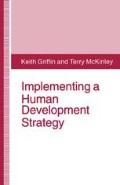Abstract
The structure of incentives generates the signals that guide the allocation of resources and influence the division of investment among natural, physical and human capital. The structure of incentives cannot, however, determine the speed of response — the elasticity of supply — to economic opportunities. That depends on other things: initial conditions, institutional arrangements, the capabilities of people and government initiatives. In this chapter we shall focus on the role of government and in particular on the way government expenditure can contribute to human development.
Access this chapter
Tax calculation will be finalised at checkout
Purchases are for personal use only
Preview
Unable to display preview. Download preview PDF.
Notes
Giovanni Andrea Cornia and Frances Stewart, ‘Two Errors of Targeting’, UNICEF, International Child Development Centre, Florence, Italy, Innocenti Occasional Papers, EPS 36, March 1993.
The expression comes from the title of a book by Giovanni Andrea Cornia, Richard Jolly and Frances Stewart (eds), Adjustment with a Human Face (Oxford: Clarendon Press, 1987).
See UNDP, Balanced Development: An Approach to Social Action in Pakistan, loc. cit. and UNDP, Human Development in Bangladesh (Dhaka, Bangladesh, 1992).
For example, in Indonesia in 1978 it is estimated that 83 per cent of state subsidies to higher education accrued to the upper-income group, 10 per cent to the middle-income group and only 7 per cent to the lower-income group. Indonesia is perhaps an extreme case, but a similar pattern is evident in Chile, Colombia and Malaysia. See George Psacharopoulos, ‘Education and Development: A Review’, World Bank Research Observer, Vol. 3, No. 1, January 1988, Table 5, p. 104.
Excluding China and India, which have good records, the primary school enrolment rate in the ‘other low-income economies’ was 77 per cent in 1989. In the ‘middle-income economies’ the enrolment rate was 101 per cent. See World Bank, World Development Report 1992 (New York: Oxford University Press, 1992).
UNDP, Human Development Report 1992 (New York: Oxford University Press, 1992).
See UNDP, Human Development in Bangladesh, loc. cit. and UNDP, Making People Matter: Introductory Comment on a Human Development Strategy for Ghana, Accra, Ghana, draft June 1992.
This is now widely recognised. See, for instance, the World Bank, World Development Report 1993 (New York: Oxford University Press, 1993), which is devoted to ‘Investing in Health’.
See Amartya Sen, Poverty and Famines: An Essay on Entitlement and Deprivation (Oxford: Oxford University Press, 1981);
and Jean Drèze and Amartya Sen, Hunger and Public Action (Oxford: Oxford University Press, 1989).
Thienchay Kiranandana and Kraisid Tontisirin, Eradicating Child Malnutrition: Thailand’s Health, Nutrition and Poverty Alleviation Policy in the 1980s, UNICEF, International Child Development Centre, Innocenti Occasional Papers, Economic Policy Series, No. 23, January 1992.
Saadet Deger and Somnath Sen, Military Expenditure: The Political Economy of International Security, Stockholm International Peace Research Institute (New York: Oxford University Press, 1990).
Fundación para la Educación Superior y el Desarrollo, Un Plan de Desarrollo Humano de Largo Plazo para Colombia (Bogotá, Colombia, 1992).
See Janos Kornai, Economics of Shortage, 2 vols (New York: North-Holland, 1980).
In Karachi, Pakistan, for example, the benefits of Provincial and Municipal expenditures on transportation, education, health, law and order, water supply and roads are nearly four times larger for the highest income group than for the lowest. See Aisha Ghaus, ‘The Incidence of Public Expenditure in Karachi’, Pakistan Journal of Applied Economics, Vol. VIII, No. 1, Summer 1989, Table 2, p. 98.
See P. N. Dhar, ‘Economic Reforms: Why We Need Them’, Observer Research Foundation, New Delhi, India, Occasional Paper, March 1992.
See UNDP, Human Development Report 1991 (New York: Oxford University Press, 1991), Chapter 3.
Author information
Authors and Affiliations
Copyright information
© 1994 Keith Griffin and Terry McKinley
About this chapter
Cite this chapter
Griffin, K., McKinley, T. (1994). Reallocation of Public Sector Resources. In: Implementing a Human Development Strategy. Palgrave Macmillan, London. https://doi.org/10.1007/978-1-349-23543-8_3
Download citation
DOI: https://doi.org/10.1007/978-1-349-23543-8_3
Publisher Name: Palgrave Macmillan, London
Print ISBN: 978-0-333-61818-9
Online ISBN: 978-1-349-23543-8
eBook Packages: Palgrave Economics & Finance CollectionEconomics and Finance (R0)

